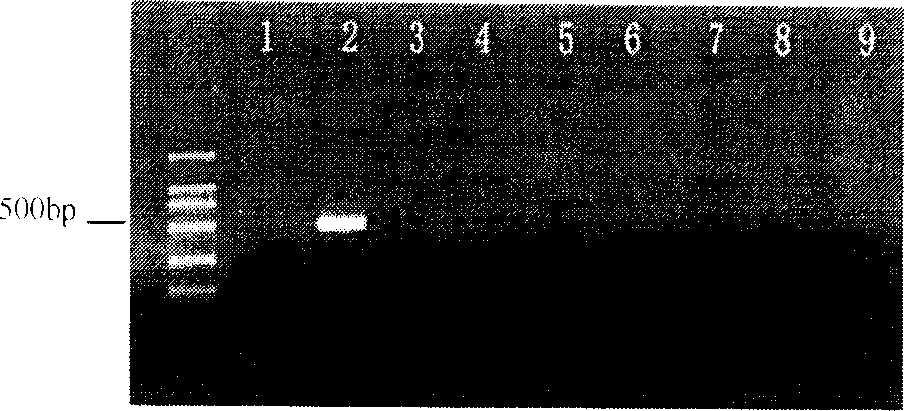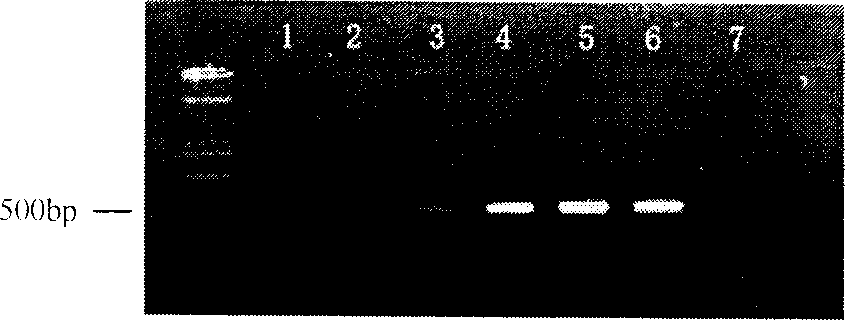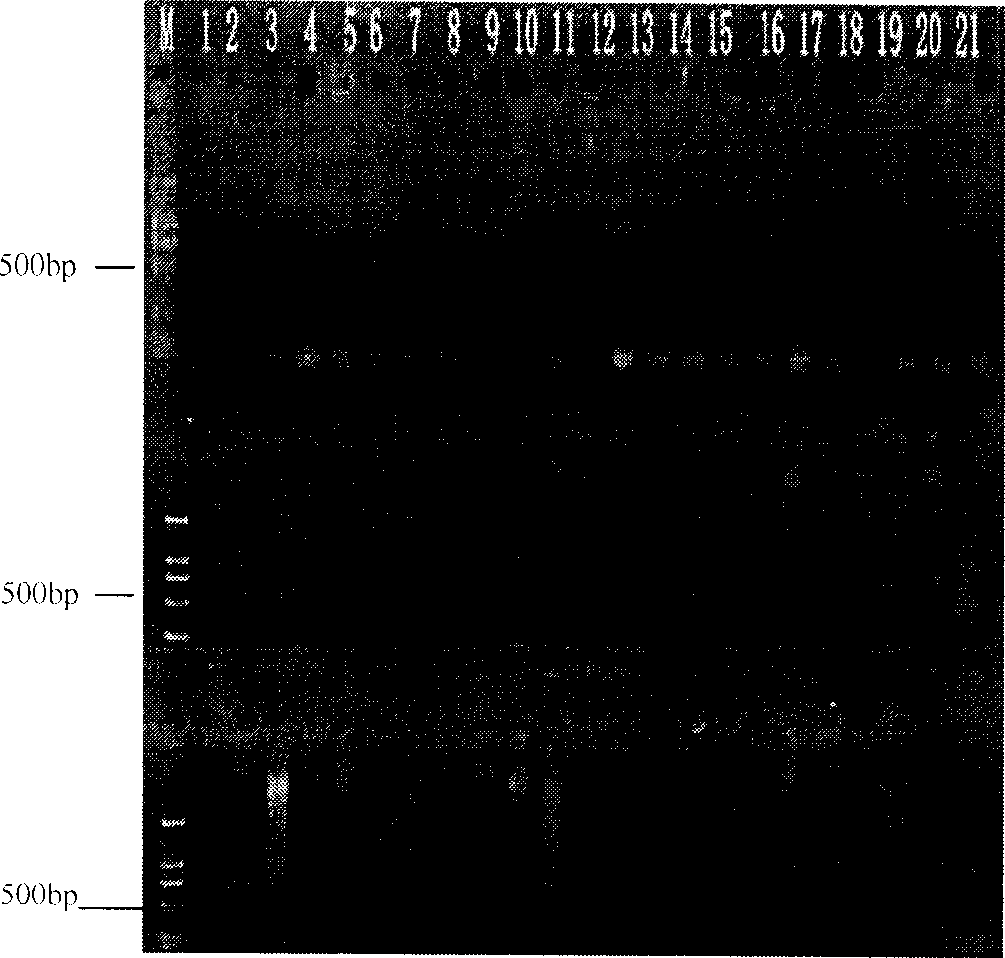Wheat stripe rust bacteria molecalar detecting method
A technology for molecular detection of wheat stripe rust, applied in biochemical equipment and methods, analytical materials, measuring devices, etc., can solve the problems that the molecular detection of wheat stripe rust has not been reported.
- Summary
- Abstract
- Description
- Claims
- Application Information
AI Technical Summary
Problems solved by technology
Method used
Image
Examples
Embodiment 1
[0025] 1. Sample collection
[0026] On December 22, 2003, in Changwu, Shaanxi, 300 asymptomatic wheat leaf samples were randomly collected. The wheat leaves were rinsed with deionized water and stored at -80°C for later use.
[0027] 2. Detection of wheat stripe rust
[0028] (1) extracting wheat leaf genomic DNA;
[0029] (2) PCR amplification, 25μL reaction system was placed in PCR thin-walled tubes: 10×Buffer 2.5μL, 25mmol / LMgCL2 2.0μL, 2.5mmol / LdNTP 1.5μL, upstream primer and downstream primer 20ng each, wheat leaf Genomic DNA 10ng, Taq DNA polymerase 1.0U, and finally make up to 25μL with sterile deionized water. Centrifuge for 10 sec, put the PCR thin-walled tube into the PCR instrument for amplification. Amplification conditions were as follows: the first cycle of pre-denaturation at 94°C for 3 minutes; followed by denaturation at 94°C for 50 sec, annealing at 54°C for 90 sec, and extension at 72°C for 2 min, a total of 35 cycles; the last cycle, extension at 72°C ...
Embodiment 2
[0034] 1. Sample collection
[0035] On February 19, 2004, 410 asymptomatic wheat leaf samples were randomly collected in Peng Zuyuan, Baoji, Shaanxi. The wheat leaves were rinsed with deionized water and stored at -80°C for later use.
[0036] 2. Detection of wheat stripe rust
[0037] (1) extracting wheat leaf genomic DNA;
[0038] (2) PCR amplification, 25μL reaction system was placed in PCR thin-walled tubes: 10×Buffer 2.5μL, 25mmol / LMgCL2 2.0μL, 2.5mmol / LdNTP 1.5μL, upstream primer and downstream primer 30ng each, wheat leaf Genomic DNA 30ng, Taq DNA polymerase 1.0U, and finally make up to 25μL with sterile deionized water. Centrifuge for 10 sec, put the PCR thin-walled tube into the PCR instrument for amplification. Amplification conditions were as follows: the first cycle of pre-denaturation at 94°C for 3 minutes; followed by denaturation at 94°C for 50 sec, annealing at 54°C for 90 sec, and extension at 72°C for 2 min, a total of 35 cycles; the last cycle, extensio...
Embodiment 3
[0043] 1. Sample collection
[0044] On March 24, 2004, 391 asymptomatic wheat leaf samples were randomly collected in Gong Town, Baoji County, Shaanxi Province. The wheat leaves were rinsed with deionized water and stored at -80°C for later use.
[0045] 2. Detection of wheat stripe rust
[0046] (1) extracting wheat leaf genomic DNA;
[0047](2) PCR amplification, 25μL reaction system was placed in PCR thin-walled tubes: 10×Buffer 2.5μL, 25mmol / LMgCL2 2.0μL, 2.5mmol / LdNTP 1.5μL, upstream primer and downstream primer 40ng each, wheat leaf Genomic DNA 40ng, Taq DNA polymerase 1.0U, and finally make up to 25μL with sterile deionized water. Centrifuge for 10 sec, put the PCR thin-walled tube into the PCR instrument for amplification. Amplification conditions were as follows: the first cycle of pre-denaturation at 94°C for 3 minutes; followed by denaturation at 94°C for 50 sec, annealing at 54°C for 90 sec, and extension at 72°C for 2 min, a total of 35 cycles; the last cycle...
PUM
 Login to View More
Login to View More Abstract
Description
Claims
Application Information
 Login to View More
Login to View More - R&D
- Intellectual Property
- Life Sciences
- Materials
- Tech Scout
- Unparalleled Data Quality
- Higher Quality Content
- 60% Fewer Hallucinations
Browse by: Latest US Patents, China's latest patents, Technical Efficacy Thesaurus, Application Domain, Technology Topic, Popular Technical Reports.
© 2025 PatSnap. All rights reserved.Legal|Privacy policy|Modern Slavery Act Transparency Statement|Sitemap|About US| Contact US: help@patsnap.com



